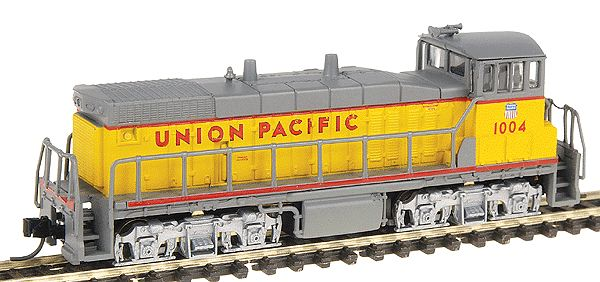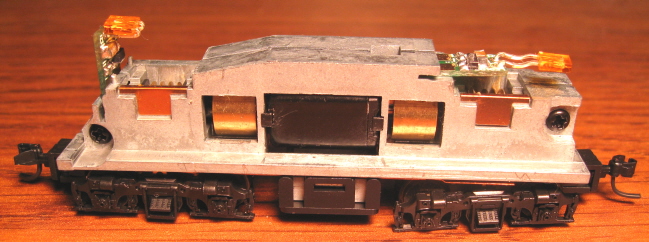

Introduced: 2005
Con-Cor's MP15 model was that firm's first attempt at a new yard switcher since their SW1200 (nee SW1500) "cow and calf" locos of the 80's and 90's. Sadly, it came out right on the heels of Atlas's mostly superior MP15 model. Released a few years earlier, it might've caused quite a sensation amongst N-scalers. Unfortunately, some of its compromises are a bit disappointing for a 2005 model. Rumor has it that this model was actually designed in the 1980s, and it wasn't until Atlas came out with a competing model that Con-Cor finally got around to releasing their's. Still, given its reasonable price (less than $60 as of this 2008 writing), it'll probably find some sort of place in the N scale locomotive pantheon.

The chassis is all-metal, split-frame and quite hefty. The motor is a closed-sided can (3-poles / straight-wound) with dual flywheels. All wheels provide pickup (no traction tires). Pickup is of the "low-friction" ilk, with current transferred from sticky-uppy wipers on the trucks to long, skinny metal contacts on the chassis. All wheels are geared and all gearing is plastic. White-LED directional lighting is provided by PC boards mounted on either end of the chassis. Couplers are truck-mounted Micro-Trains. The wheels are blackened and low-profile (no problems on Code-55 rails). There is no specific provision for DCC.
Performance is quite excellent - smooth, quiet, nimble throttle response, great pickup, decent slow-speed creep, etc. Better still, these are very impressive pullers (out-pulling Atlas's MP15 by a wide margin). On the downside, the top-end speed is pretty excessive (for people that worry about such things). And although it's nice that these come with Micro-Trains couplers, the fact that they're truck-mounted (with open pilots) makes them a but of a mixed blessing. Further, the complete lack of DCC support is a major disappointment for a 2005 model. Lastly, paint and shell-detailing (particularly the handrails) really pale in comparison to the Atlas model.
Ultimately, this is nice running model that looks good (if not great). And as such, I can't drop it down into the "B" category simply because Atlas had the temerity to release something that is (in certain respects) a bit better. So, go with the one that meets your needs. They both run great, but Con-Cor has the better puller (costing a little less), whereas Atlas has the better looker (costing a bit more). However, if you're a DCC guy, Atlas is pretty much your only option.
So, that's that. Now, allow me to turn the podium over to Con-Cor (where they will try to explain their decision-making vis'a'vis this model) -
"Regrettably the new MP-15 is not set up for DCC. This was a tough decision we had to make, but the short, narrow engine shell did not allow us to leave enough space inside without removing at least one of the flywheels and some of the weight. This would have resulted in an engine that would not have pulled many cars. This was the same problem Atlas faced with their Shay model.
"The state of the art for DCC is rapidly advancing, and we know some of the DCC manufacturers are pretty clever at electronics and it will not be too long before they make a decoder system that will be small enough to fit into small bodies such as the Shay and our new MP-15. So we chose to make a model that will pull and operate very well in the analog mode, and will also pull very well once the DCC manufacturers come up with a small enough unit. We also have followed with interest the recent articles in the model press about details now being too scale, too delicate, and breaking off easily. Thus we beefed up the handrails a bit as this model is so small there is no practical way to pick up the model without handling the handrails.
"Up close under a magnifying glass the handrails will look a bit large, but at a normal viewing distance of about 36 inches or more as on the average layout or module we think they look just fine. Again a case of heads you lose, tails you lose. If we make them too delicate a lot of people break them and complain and want us to replace expensive body shells. If we make them easier to handle, the super scale fellows fame us... go figure. One of the etched brass people will undoubtably make some scale etched brass handrails as a replacement item, so go that route if you are so inclined. We know this will not make everyone happy, but this is a case of heads you lose, tails you lose no matter which route we took."
To remove the shell, use a small screwdriver to separate the chassis from the shell (find the seam, insert screwdriver and pry). It doesn't take a whole lot to get things separated, but it does take a bit more effort than your typical "grab the shell and pull" diesel.
Grade: A